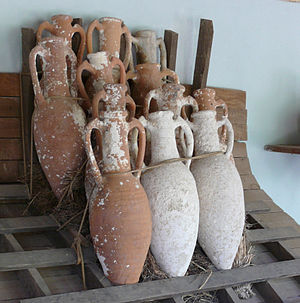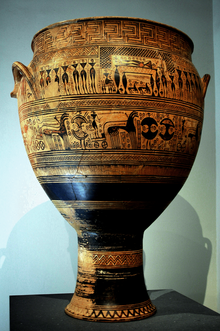
Back فخار إغريقي قديم Arabic Вазапіс Старажытнай Грэцыі Byelorussian Древногръцко грънчарство Bulgarian Starověká řecká keramika Czech Авалхи Грецин ваза сăрлавĕ CV Antike griechische Töpfer German Αρχαία ελληνική κεραμική Greek Ceramiko de antikva Grekio Esperanto Cerámica griega Spanish Vanakreeka keraamika Estonian


Pottery, due to its relative durability, comprises a large part of the archaeological record of ancient Greece, and since there is so much of it (over 100,000 painted vases are recorded in the Corpus vasorum antiquorum),[1] it has exerted a disproportionately large influence on our understanding of Greek society. The shards of pots discarded or buried in the 1st millennium BC are still the best guide available to understand the customary life and mind of the ancient Greeks. There were several vessels produced locally for everyday and kitchen use, yet finer pottery from regions such as Attica was imported by other civilizations throughout the Mediterranean, such as the Etruscans in Italy.[2] There were a multitude of specific regional varieties, such as the South Italian ancient Greek pottery.
Throughout these places, various types and shapes of vases were used. Not all were purely utilitarian; large Geometric amphorae were used as grave markers, kraters in Apulia served as tomb offerings and Panathenaic Amphorae seem to have been looked on partly as objets d'art, as were later terracotta figurines. Some were highly decorative and meant for elite consumption and domestic beautification as much as serving a storage or other function, such as the krater with its usual use in diluting wine.
Earlier Greek styles of pottery, called "Aegean" rather than "Ancient Greek",[citation needed] include Minoan pottery, very sophisticated by its final stages, Cycladic pottery, Minyan ware and then Mycenaean pottery in the Bronze Age, followed by the cultural disruption of the Greek Dark Age. As the culture recovered Sub-Mycenaean pottery finally blended into the Protogeometric style, which begins Ancient Greek pottery proper.[citation needed]
The rise of vase painting saw increasing decoration. Geometric art in Greek pottery was contiguous with the late Dark Age and early Archaic Greece, which saw the rise of the Orientalizing period. The pottery produced in Archaic and Classical Greece included at first black-figure pottery, yet other styles emerged such as red-figure pottery and the white ground technique. Styles such as West Slope Ware were characteristic of the subsequent Hellenistic period, which saw vase painting's decline.
- ^ "The Corpus Vasorum Antiquorum ('Corpus of Ancient Vases') is the oldest research project of the Union Académique Internationale". Corpus vasorum antiquorum. University of Oxford. Union Académique Internationale. Retrieved 16 May 2016.
- ^ John H. Oakley (2012). "Greek Art and Architecture, Classical: Classical Greek Pottery," in Neil Asher Silberman et al. (eds), The Oxford Companion to Archaeology, Vol 1: Ache-Hoho, 2nd Edition, 641–644. Oxford & New York: Oxford University Press. ISBN 978-0-19-973578-5, p. 641.